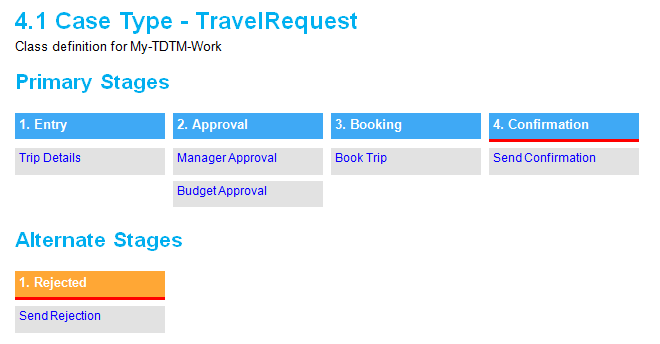Attachment support for requirements
Valid from Pega Version 7.1.6
Requirements now support attachments. You can add attachments from the Designer Studio > Application > Profile > Requirements landing page, the Add/Edit Requirement modal, or the requirement rule form.
Enhanced document generation
Valid from Pega Version 7.1.6
The following usability improvements have been made to documents generated by the Application Document Wizard:
- Stages and Processes now appear for case types that use Case Lifecycle Management. This diagram includes hyperlinks to corresponding sections in the document and is scoped to top-level processes only.

- All flows (excluding pyStartCase) referenced by a case type now appear in documents. This removes previous constraints on non-starting, draft, and checked out flows.
- Entity Relationship Diagrams (ERDs) are now embedded in documents as Visio objects.
- Sections without content are omitted from the generated document.
- Screenshots are labeled.
- Requirement text (Long Description) is included in the Requirements Matrix section.
- Linked requirements appear in context beneath their associated specification.
- Acceptance Criteria appears in context beneath the associated specification, report, or correspondence item.
Create data page from REST integration
Valid from Pega Version 7.1.6
When you create a REST integration, you can choose to create a data page (and its related data type and data transforms) that can use the integration as one of its sources.
Use SAML 2.0 to provide single sign-on authentication
Valid from Pega Version 7.1.6
Configure a SAML 2.0 authentication service to provide web single sign-on (SSO) convenience to product users in your enterprise. A one-click option lets you import Identity Provider (IdP) metadata and make use of automated certificate management.
Define and manage features during application development
Valid from Pega Version 7.3
You can now define and manage the features and child features that you want to implement in your application. A feature represents any capability in your application that you want to promote to stakeholders during the application development process. When you develop an application and design case types, you can link each case type to top-level features in Designer Studio. In addition, you can associate existing rules with features, which maintains traceability and makes it easier for you to extend the application because you can identify the rules that are associated with each feature.
For more information, see Features.
Logging service now uses Apache Log4j 2
Valid from Pega Version 7.3
The Pega® Platform now uses the Apache Log4j 2 logging service. Apache Log4j 2 improves performance and provides support for all log file appender types. As a result of this upgrade, the prlogging.xml file has been renamed to prlog4j2.xml and the format of the file has changed considerably.
For details about the new file format see Pega Platform logging with the Log4j 2 logging service.
For new installations or for upgrades to systems that were using the default logging configuration, no changes are needed. For information about updating custom log files after upgrading, see Customizations to the prlogging.xml file must be manually ported after upgrade. For information about updating your socket server if you use remote logging, see Socket server has changed for remote logging. For information about updated the web.xml file after upgrading, see Log file description in web.xml incorrect after upgrade to Apache Log4j2.
Customizations to the prlogging.xml file must be manually ported after upgrade
Valid from Pega Version 7.3
As a result of the upgrade from the Apache Log4j 1 logging service to the Apache Log4j 2 logging service, the name of the logging configuration file has changed from prlogging.xml to prlog4j2.xml and the format of the file has changed considerably. If you customized your prlogging.xml file, port the customizations to the new prlog4j2.xml file. If you do not port the changes, the Pega® Platform uses the default prlog4j2.xml file and disregards your customized prlogging.xml file.
For more information about customizing your log files, see the Apache Log4j 2 documentation.
Socket server has changed for remote logging
Valid from Pega Version 7.3
As a result of the upgrade from the Apache Log4j 1 logging service to the Apache Log4j 2 logging service, the socket server that is used for remote logging has changed from the Log4j remote logging package with the LogFactor5 log analysis tool to TcpSocketServer. If you use remote logging, update your socket server to TcpSocketServer. For more information, see Installing and using remote logging.
Create connections to repositories
Valid from Pega Version 7.3
Pega® Platform can communicate with common repository technologies. Whenever an action creates a RAP, Pega Platform can browse, publish, or fetch artifacts: for example, when exporting an application, product, branch, or component. Repositories are instances of the Data-Repository class which holds all necessary connection information.
Pega Platform includes tools to connect with the following repository types:
- JFrog Artifactory
- Amazon S3
For more information, see Creating a JFrog Artifactory or Amazon S3 repository connection.
Automatically process cases with SharePoint
Valid from Pega Version 7.3
You can now use Microsoft SharePoint Online to store and source case and Pulse attachments and to store and source attachments during automated case processing. Users only have to provide authentication and authorization details the first time they access SharePoint Online or when the trust has expired. The authentication profile must be OAuth 2.0 with a grant type of authorization code. The SharePoint Online component can be downloaded from Pega Exchange. For more information, see Downloading and configuring pluggable content management components.

